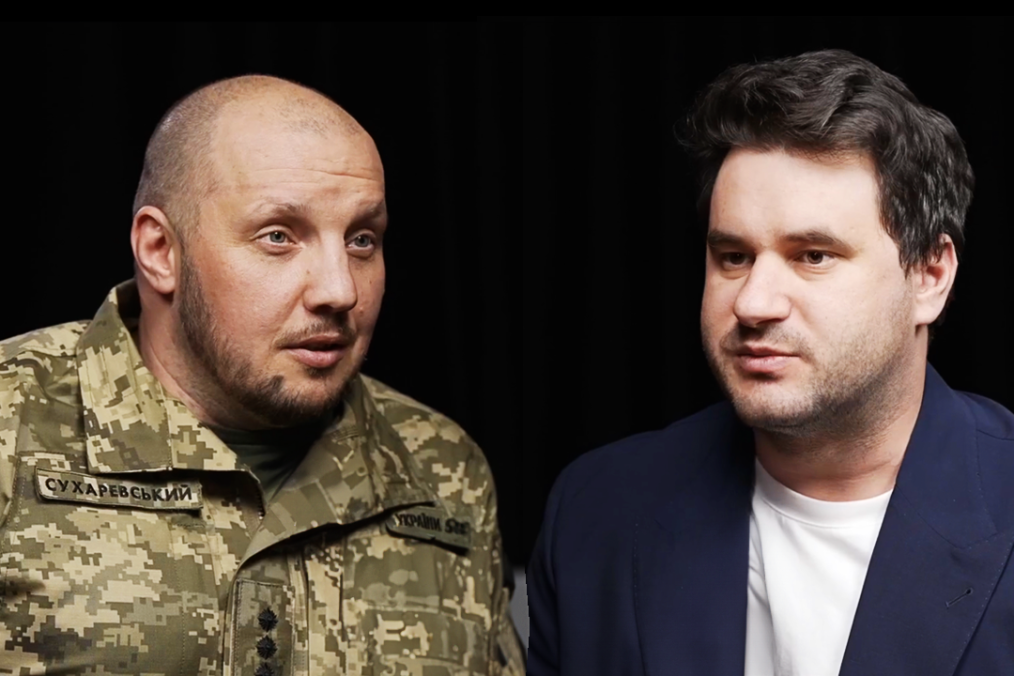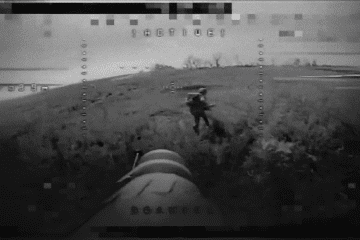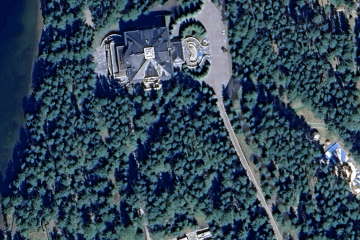- Category
- War in Ukraine
A Conversation with Ukraine's Deputy Commander-in-Chief on Building the World’s First-Ever Drone Forces

Vadym Sukharevskyi stands at the forefront of a game changing initiative: establishing the Ukrainian military’s Unmanned Systems Forces, a branch with no global equivalent.
Vadym Sukharevskyi, a Colonel in the Armed Forces of Ukraine and Deputy Commander-in-Chief is the man responsible for the development and deployment of Ukraine’s unmanned systems. A seasoned commander with over 20 years of service, Sukharevskyi was among the first to defend Ukraine during the Russian invasion in 2014. Today, he faces a different challenge: ensuring Ukraine’s effective use of unmanned systems, a defining feature of the Russian-Ukrainian war. But now, it’s not just about ordinary “Mavic” drones; it’s an arsenal that includes dozens of types of aerial drones, naval drones, and even robots—all integral to the Ukrainian military. Sukharevskyi’s mission is to maximize their impact, destroying enemy equipment and personnel, while preserving the lives of Ukrainian soldiers
We spoke with Vadym Sukharevskyi about his work and the challenges facing the Ukrainian army. You can watch the full interview below.
On the Unmanned Systems Forces
Establishing a new military branch, the Unmanned Systems Forces marks a historic moment. The last time this occurred was with the founding of the Air Force. Today, we are forming units geared towards fifth-generation warfare. What was once the realm of science fiction — robots, cyborgs, androids — is now our battlefield. Just 20 years ago, these were scenes in movies; today, they’re our reality. The creation of the Unmanned Systems Forces is a groundbreaking step, watched by the world. We are setting an example of innovation and effectiveness, allowing us to provide an asymmetrical response to our enemy’s superior firepower.
The road to a new branch of military
This development has been a long time coming. In 2014, drones on the battlefield were met with skepticism; their use was minimal. Today, not a single shot is fired without the use of UAVs.
The unprecedented aspect lies not just in our drone deployment, not just in eliminating our enemy, and not just in protecting our personnel. We are establishing a separate branch of the military to make drone use widespread and systematic. We will continue to support, develop, and work in the scientific and technological realm to achieve this goal.
What does it take to build a system?
Everyone has seen the captivating videos of FPV drones diving into enemy tanks or BMPs. However, these videos represent the culmination of human expertise and skills in a specific area, and there are 1,000 kilometers of front lines to consider.
Our objective is to take this positive expertise and scale it up. Therefore, we are establishing a command structure capable of organizing a unified tactic, gathering the best practices for drone deployment in the air, on water, and on land, and implementing them across the army. This encompasses both countering the enemy and mitigating their threats.
The newly created military branch will be responsible for all types of unmanned systems: drones ranging from FPV to those targeting Russian refineries, along with naval drones and robotic platforms.
We’ve made remarkable strides. In late 2023, we established the core platoons of our UAV companies. Now, we’re bolstering the staffing of our divisions, incorporating platoons and companies dedicated to ground-based robotics. We’ve even formed specialized naval and deep-air units. The next step is intensive personnel training to ensure we use our resources to their full potential. The task ahead is immense, but we’re ready.
The technological race on the frontlines
Personally, I draw an analogy between what is happening on the front lines today and the Cold War era between the US, NATO, and the Soviet Union. For every action, there was a counteraction.
The situation at the front is complex and rapidly evolving. Our increased drone usage led the enemy to strengthen their electronic warfare (EW) capabilities. We’ve responded by upgrading our own EW and drones, and they’ve countered with “Turtles” (anti-drone systems). This technological arms race is incredibly dynamic, demanding constant innovation and posing a major challenge. A simple example: to overcome enemy EW, we’re already using drones with fiber optics. It’s a promising and cost-effective solution. This kind of intellectual challenge fuels the search for new and creative solutions.
The Russians are playing catch-up, largely copying our innovations in drones and robotics. For example, back in 2022, when I was a brigade commander, I used a ground kamikaze drone with great success. It caused a stir on their social media. Now, they’re finally trying to replicate that. They may have the resources and factories for mass production, but we have the edge in ingenuity.
In my opinion, Ukraine has a distinct technological advantage in this conflict. This stems from the inherent nature of Ukrainian society: while Russia relies heavily on a top-down power structure, we respect hierarchy but draw our strength from horizontal connections. Our people on the ground are empowered to find innovative solutions independently. Decentralization in all forms — technology, command, and communication — is our key strength, and we are utilizing it to the fullest.
Furthermore, Ukraine has become a real-world testing ground. This provides advantages for both technological development and for businesses. We need the support of our allies, and in turn, they benefit from our battlefield experience and knowledge. Let’s be honest: we need their resources and technology, particularly in areas like command systems, communications, and reconnaissance. However, it is Ukraine that holds the expertise in effective aerial and naval combat, setting an example for the rest of the world.
On war and the development of unmanned systems
The goal for 2024 was clear: one million drones for the Armed Forces of Ukraine. Based on the results of the first quarter, I can confidently say that we are exceeding this goal, though I can’t disclose exact numbers.
The intensity of this war demands a massive drone force. On average, a brigade loses six Mavics per day, and that’s just during daylight hours. A similar number is lost at night. This is an average — some areas experience higher or lower losses. The math is simple, and the need is immense. Furthermore, this only accounts for Mavics; we also require FPVs, bombers, reconnaissance drones, and the necessary auxiliary equipment like repeaters. The overall scale of our requirements is staggering.
Our large network of manufacturers provides crucial flexibility. While we lack a single unified platform for various drone types, this decentralized approach ensures that a single strike cannot halt our resistance.
We face a range of tasks outlined by the president, including countering missiles, artillery, FABs, and enemy drones. Developing our own equivalent to the Russian “Lancet” is one such priority. Another is expanding naval drone capabilities — launching torpedoes, carrying MANPADS, or the critical task of demining the Black Sea, which is potentially littered with hundreds of thousands of mines.
What are the difficulties we face? Their scale is evident on any world map. Moreover, war is not a movie; it goes on around the clock, without days off.
In our work, we remember that the fundamental goal of unmanned systems is to save soldiers' lives. This is paramount, and the development of this technology is driven by this principle. If a robot can engage in combat or interact with mines, it should. That’s the motivation behind our tireless work.
-29a1a43aba23f9bb779a1ac8b98d2121.jpeg)

-f88628fa403b11af0b72ec7b062ce954.jpeg)
-b63fc610dd4af1b737643522d6baf184.jpg)



-24deccd511006ba79cfc4d798c6c2ef5.jpeg)